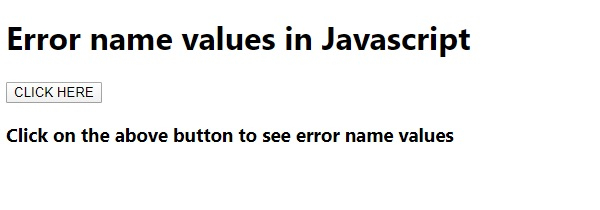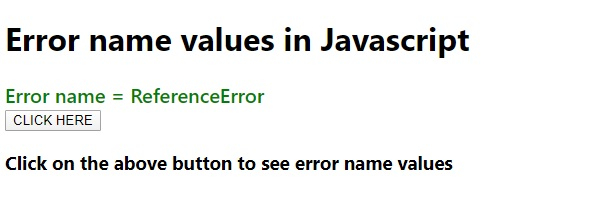
 Data Structure
Data Structure Networking
Networking RDBMS
RDBMS Operating System
Operating System Java
Java MS Excel
MS Excel iOS
iOS HTML
HTML CSS
CSS Android
Android Python
Python C Programming
C Programming C++
C++ C#
C# MongoDB
MongoDB MySQL
MySQL Javascript
Javascript PHP
PHP
- Selected Reading
- UPSC IAS Exams Notes
- Developer's Best Practices
- Questions and Answers
- Effective Resume Writing
- HR Interview Questions
- Computer Glossary
- Who is Who
Explain the Error Name Values in JavaScript with examples.
The error name value is used for setting or returning the error name. The error name can return the below values.
| Sl.No | Error Name & Description |
|---|---|
| 1 | EvalError It represents an error in the eval() function |
| 2 | RangeError It happens when a numeric value is out of its range |
| 3 | ReferenceError It happens when an illegal reference has occured |
| 4 | SyntaxError It represents a syntax error |
| 5 | TypeError It represents a type error |
| 6 | URIError It represents an error in the encodeURI(). |
Example
Following is the code for the error name values in JavaScript −
<!DOCTYPE html>
<html lang="en">
<head>
<meta charset="UTF-8" />
<meta name="viewport" content="width=device-width, initial-scale=1.0" />
<title>Document</title>
<style>
body {
font-family: "Segoe UI", Tahoma, Geneva, Verdana, sans-serif;
}
.result {
font-size: 20px;
font-weight: 500;
}
</style>
</head>
<body>
<h1>Error name values in Javascript</h1>
<div style="color: green;" class="result"></div>
<button class="Btn">CLICK HERE</button>
<h3>
Click on the above button to call a variable before it is defined
</h3>
<script>
let resEle = document.querySelector(".result");
document.querySelector(".Btn").addEventListener("click", () => {
try {
resEle.innerHTML = a;
}
catch (err) {
resEle.innerHTML = "Error name = " + err.name;
}
let a = 44;
});
</script>
</body>
</html>
Output
The above code will produce the following output −

On clicking the ‘CLICK HERE’ button −


Advertisements
